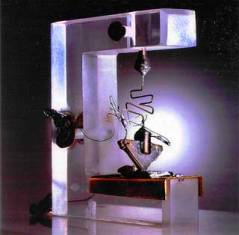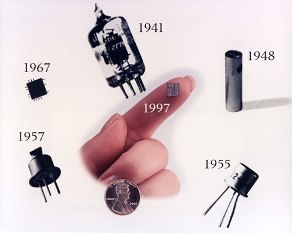Categories: Featured Articles » Interesting Facts
Number of views: 36129
Comments on the article: 9
Transistor history
 One of the significant inventions of the XX century is considered transistor inventionwho came to replace the electronic lamps.
One of the significant inventions of the XX century is considered transistor inventionwho came to replace the electronic lamps.
For a long time, lamps were the only active component of all electronic devices, although they had many shortcomings. First of all, it is a large power consumption, large dimensions, short life and low mechanical strength. These shortcomings were felt more and more sharply with the improvement and sophistication of electronic equipment.
A revolutionary revolution in radio engineering took place when outdated lamps were replaced by semiconductor amplifying devices - transistors, devoid of all the mentioned disadvantages.
The first operational transistor was born in 1947, thanks to the efforts of employees of the American company Bell Telephone Laboratories. Their names are now known throughout the world. These are scientists - physicists W. Shockley, D. Bardin and W. Brighten. Already in 1956, all three were awarded the Nobel Prize in Physics for this invention.
But, like many great inventions, the transistor was not immediately noticed. Only in one of the American newspapers was it mentioned that Bell Telephone Laboratories demonstrated its device called a transistor. It was also said that it can be used in some areas of electrical engineering instead of electron tubes.
The transistor shown was in the form of a small metal cylinder 13 mm long and was demonstrated in a receiver that did not have electron tubes. To everything else, the company claimed that the device can be used not only for amplification, but also for the generation or conversion of an electrical signal.
Fig. 1. The first transistor
Fig. 2. John Bardin, William Shockley and Walter Brattain. For collaboration in developing the world's first operational transistor in 1948, they shared the 1956 Nobel Prize.
But the capabilities of the transistor, as, indeed, of many other great discoveries, were not immediately understood and appreciated. To arouse interest in the new device, Bell firmly advertised it at seminars and articles, and granted everyone with a license to manufacture it.
Manufacturers of electronic lamps did not see a serious competitor in the transistor, because it was impossible at once, in one fell swoop, to discount the thirty-year history of the production of lamps of several hundred designs, and multimillion-dollar investments in their development and production. Therefore, the transistor entered the electronics not so fast, since the era of electron tubes was still ongoing.
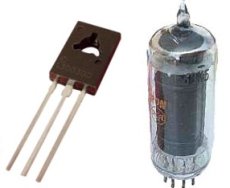
Fig. 3. Transistor and electronic lamp
First Steps to Semiconductors
Since ancient times, two types of materials have been used in electrical engineering mainly - conductors and dielectrics (insulators). Metals, salt solutions, and some gases have the ability to conduct current. This ability is due to the presence in the conductors of free charge carriers - electrons. In conductors, electrons are quite easily detached from the atom, but those metals that have low resistance (copper, aluminum, silver, gold) are most suitable for transferring electrical energy.
Insulators include substances with high resistance, their electrons are very tightly bound to the atom. This is porcelain, glass, rubber, ceramics, plastic. Therefore, there are no free charges in these substances, and therefore there is no electric current.
It is appropriate to recall the wording from physics textbooks that electric current is the directional movement of electrically charged particles under the influence of an electric field. In insulators, there is simply nothing to move under the influence of an electric field.
However, in the process of studying electrical phenomena in various materials, some researchers were able to "feel" for semiconductor effects.For example, the first crystalline detector (diode) was created in 1874 by the German physicist Karl Ferdinand Brown based on the contact of lead and pyrite. (Pyrite is an iron pyrite; when it hits a chair, a spark is carved, which is why it got the name from the Greek “feast” - fire). Later, this detector successfully replaced the coherer in the first receivers, which significantly increased their sensitivity.
In 1907, Beddecker, studying the conductivity of iodine copper, found that its conductivity increases 24-fold in the presence of an iodine impurity, although iodine itself is not a conductor. But all these were random discoveries that could not be given a scientific justification. A systematic study of semiconductors began only in 1920 - 1930 years.
A great contribution to the study of semiconductors was made by a Soviet scientist at the famous Nizhny Novgorod radio laboratory O.V. Losev. He went down in history primarily as the inventor of cristadine (an oscillator and amplifier based on a diode) and an LED. See more about this here: History of LEDs. Glow of Losev.
At the dawn of transistor production, the main semiconductor was germanium (Ge). In terms of energy consumption, it is very economical, the voltage for unlocking its pn junction is only 0.1 ... 0.3V, but many parameters are unstable, so it replaced silicon (Si).
The temperature at which germanium transistors are operable is not more than 60 degrees, while silicon transistors can continue to operate at 150. Silicon, as a semiconductor, surpasses germanium in other properties, primarily in frequency.
In addition, the reserves of silicon (ordinary sand on the beach) in nature are unlimited, and the technology for cleaning and processing it is simpler and cheaper than the rare in nature element of germanium. The first silicon transistor appeared shortly after the first germanium transistor - in 1954. This event even entailed a new name “silicon age”, not to be confused with the stone!
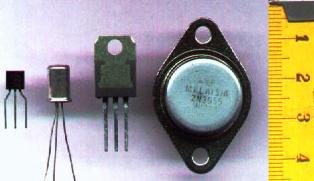
Fig. 4. The evolution of transistors
Microprocessors and semiconductors. Silicon Age Sunset
Have you ever wondered why recently almost all computers have become multi-core? The terms dual-core or quad-core are common to everyone. The fact is that the increase in microprocessor performance by increasing the clock frequency, and increasing the number of transistors in one package, for silicon structures is almost close to the limit.
An increase in the number of semiconductors in one housing is achieved by reducing their physical dimensions. In 2011, INTEL already developed a 32 nm process technology in which the transistor channel length is only 20 nm. However, such a decrease does not bring a noticeable increase in the clock frequency, as it was up to 90 nm technology. It is obvious that it is time to move on to something fundamentally new.
Fig. 5. History of transistors
Graphene - the semiconductor of the future
In 2004, physicists discovered a new semiconductor material. graphene. This major candidate for silicon replacement is also a carbon group material. On its basis, a transistor is created that operates in three different modes.
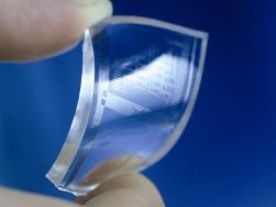
Fig. 6. Graphene

Fig. 7. Image of a field graphene transistor obtained using a scanning electron microscope
Compared with existing technologies, this will allow reducing the number of transistors in one case by exactly three times. In addition, according to scientists, the operating frequencies of the new semiconductor material can reach up to 1000 GHz. The parameters, of course, are very tempting, but so far the new semiconductor is at the development and study stage, and silicon is still a workhorse. His age has not yet ended.
Boris Aladyshkin
See also at bgv.electricianexp.com
:

